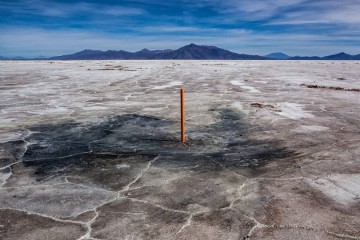
As the world scrambles to replace fossil fuels with clean energy, the environmental impact of finding all the lithium required could become a major issue in its own right.
Here’s a thoroughly modern riddle: what links the battery in your smartphone with a dead yak floating down a Tibetan river? The answer is lithium – the reactive alkali metal that powers our phones, tablets, laptops and electric cars.
In May 2016, hundreds of protestors threw dead fish onto the streets of Tagong, a town on the eastern edge of the Tibetan plateau. They had plucked them from the waters of the Liqi river, where a toxic chemical leak from the Ganzizhou Rongda Lithium mine had wreaked havoc with the local ecosystem.
There are pictures of masses of dead fish on the surface of the stream. Some eyewitnesses reported seeing cow and yak carcasses floating downstream, dead from drinking contaminated water. It was the third such incident in the space of seven years in an area that has seen a sharp rise in mining activity, including operations run by BYD, the world’s biggest supplier of lithium-ion batteries for smartphones and electric cars. After the second incident, in 2013, officials closed the mine, but when it reopened in April 2016, the fish started dying again.
Lithium-ion batteries are a crucial component of efforts to clean up the planet. The battery of a Tesla Model S has about 12 kilograms of lithium in it, while grid storage solutions that will help balance renewable energy would need much more.

Demand for lithium is increasing exponentially, and it doubled in price between 2016 and 2018. According to consultancy Cairn Energy Research Advisors, the lithium-ion industry is expected to grow from 100-gigawatt hours (GWh) of annual production in 2017, to almost 800 GWh in 2027.
William Adams, head of research at Metal Bulletin, says the current spike in demand can be traced back to 2015 when the Chinese government announced a huge push towards electric vehicles in its 13th Five Year Plan. That has led to a massive rise in the number of projects to extract lithium, and there are “hundreds more in the pipeline,” says Adams.
But there’s a problem. As the world scrambles to replace fossil fuels with clean energy, the environmental impact of finding all the lithium required to enable that transformation could become a serious issue in its own right. “One of the biggest environmental problems caused by our endless hunger for the latest and smartest devices is a growing mineral crisis, particularly those needed to make our batteries,” says Christina Valimaki an analyst at Elsevier.
In South America, the biggest problem is water. The continent’s Lithium Triangle, which covers parts of Argentina, Bolivia and Chile, holds more than half the world’s supply of the metal beneath its otherworldly salt flats. It’s also one of the driest places on earth. That’s a real issue because to extract lithium, miners start by drilling a hole in the salt flats and pumping salty, mineral-rich brine to the surface.
Then they leave it to evaporate for months at a time, first creating a mixture of manganese, potassium, borax and lithium salts which are then filtered and placed into another evaporation pool, and so on. After between 12 and 18 months, the mixture has been filtered enough that lithium carbonate – white gold – can be extracted.
It’s a relatively cheap and effective process, but it uses a lot of water – approximately 500,000 gallons per tonne of lithium. In Chile’s Salar de Atacama, mining activities consumed 65 percent of the region’s water. That is having a big impact on local farmers – who grow quinoa and herd llamas – in an area where some communities already have to get water driven in from elsewhere.
There’s also the potential – as occurred in Tibet – for toxic chemicals to leak from the evaporation pools into the water supply. These include chemicals, including hydrochloric acid, which are used in the processing of lithium into a form that can be sold, as well as those waste products that are filtered out of the brine at each stage. In Australia and North America, lithium is mined from the rock using more traditional methods, but still requires the use of chemicals in order to extract it in a useful form. Research in Nevada found impacts on fish as far as 150 miles downstream from a lithium processing operation.

According to a report by Friends of the Earth, lithium extraction inevitably harms the soil and causes air contamination. In Argentina’s Salar de Hombre Muerto, locals claim that lithium operations have contaminated streams used by humans and livestock, and for crop irrigation. In Chile, there have been clashes between mining companies and local communities, who say that lithium mining is leaving the landscape marred by mountains of discarded salt and canals filled with contaminated water with an unnatural blue hue.
“Like any mining process, it is invasive, it scars the landscape, it destroys the water table and it pollutes the earth and the local wells,” said Guillermo Gonzalez, a lithium battery expert from the University of Chile, in a 2009 interview. “This isn’t a green solution – it’s not a solution at all.”
But lithium may not be the most problematic ingredient of modern rechargeable batteries. It is relatively abundant, and could in theory be generated from seawater in future, albeit through a very energy-intensive process.
Two other key ingredients, cobalt and nickel, are more in danger of creating a bottleneck in the move towards electric vehicles, and at a potentially huge environmental cost. Cobalt is found in huge quantities right across the Democratic Republic of Congo and central Africa, and hardly anywhere else. The price has quadrupled in the last two years.
Unlike most metals, which are not toxic when they’re pulled from the ground as metal ores, cobalt is “uniquely terrible,” according to Gleb Yushin, chief technical officer and founder of battery materials company Sila Nanotechnologies.
“One of the biggest challenges with cobalt is that it’s located in one country,” he adds. You can literally just dig up the land and find cobalt, so there’s a very strong motivation to dig it up and sell it, and a result there’s a lot of motivation for unsafe and unethical behaviour.” The Congo is home to ‘artisanal mines’, where cobalt is extracted from the ground by hand, often using child labour, without protective equipment.
There’s also a political angle to be considered. When Bolivia started to exploit its lithium supplies from about 2010, it was argued that its huge mineral wealth could give the impoverished country the economic and political heft that the oil-rich nations of the Middle East. “They don’t want to pay a new OPEC,” says Lisbeth Dahllöf, of the IVL Swedish Environmental Institute, who co-authored a report last year on the environmental footprint of electric car battery production.
In a recent paper in the journal Nature, Yushin and his co-authors argued that new battery technology needs to be developed that uses more common, and environmentally friendly materials to make batteries. Researchers are working on new battery chemistries that replace cobalt and lithium with more common and less toxic materials.

But, if new batteries are less energy-dense or more expensive than lithium, they could end up having a negative effect on the environment overall. “Assessing and reducing the environmental cost is a more complex issue than it initially appears,” says Valimaki. “For example, a less durable, yet more sustainable device could entail a larger carbon footprint once your factor in transportation and the extra packaging required.”
At the University of Birmingham, research funded by the government’s £246m Faraday Challenge for battery research is trying to find new ways of recycling lithium-ion. Research in Australia found that only two percent of the country’s 3,300 tonnes of lithium-ion waste was recycled. Unwanted MP3 players and laptops can end up in landfills, where metals from the electrodes and ionic fluids from the electrolyte can leak into the environment.
A consortium of researchers, led by the Birmingham Energy Institute are using robotics technology developed for nuclear power plants to find ways to safely remove and dismantle potentially explosive lithium-ion cells from electric vehicles. There have been a number of fires at recycling plants where lithium-ion batteries have been stored improperly, or disguised as lead-acid batteries and put through a crusher.
Because lithium cathodes degrade over time, they can’t simply be placed into new batteries (although some efforts are underway to use old vehicle batteries for energy storage applications where energy density is less critical). “That’s the problem with recycling any form of battery that has electrochemistry – you don’t know what point it is at in its life,” says Stephen Voller, CEO and founder of ZapGo. “That’s why recycling most mobile phones are not cost-effective. You get this sort of soup.”
Another barrier, says Dr. Gavin Harper of the Faraday Institution’s lithium recycling project, is that manufacturers are understandably secretive about what actually goes into their batteries, which makes it harder to recycle them properly. At the moment recovered cells are usually shredded, creating a mixture of metal that can then be separated using pyrometallurgical techniques – burning. But, this method wastes a lot of lithium.
UK researchers are investigating alternative techniques, including biological recycling where bacteria are used to process the materials, and hydrometallurgical techniques which use solutions of chemicals in a similar way to how lithium is extracted from brine, to begin with.
For Harper, it’s about creating a process to shepherd lithium-ion batteries safely through their whole lifecycle, and making sure that we’re not extracting more from the ground unnecessarily, or allowing chemicals from old batteries to do damage. “Considering that all of the materials in these batteries have already had an environmental and social impact in their extraction, we should be mindful of ensuring good custody,” he says.
